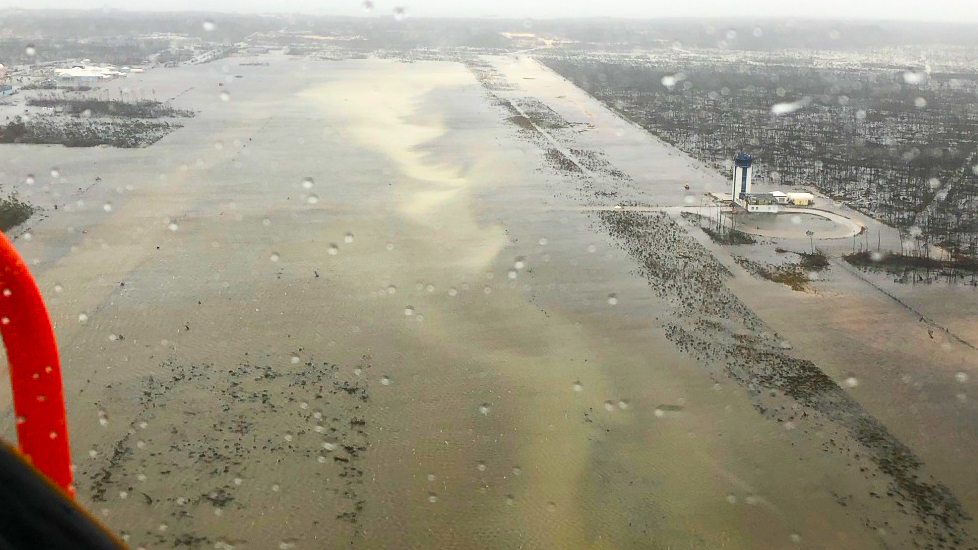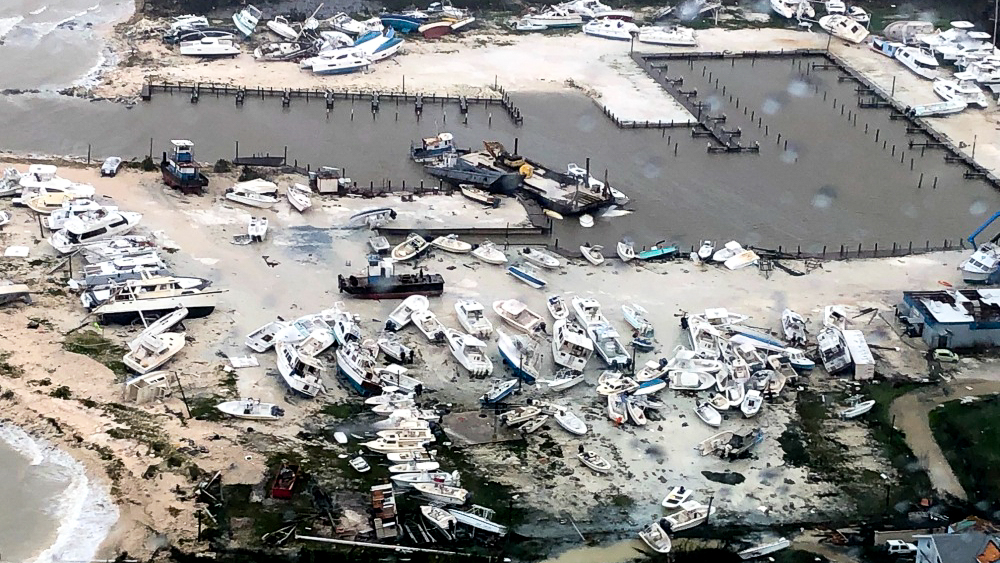Deadly Hurricane Dorian Stalled Over Bahamas
Ramon Espinosa, Dánica Coto and Michael WeissensteinSeptember 3, 2019

In this aerial photo supplied by the U.S. Coast Guard, flooding from Dorian covers sections of the Bahamas, Sept. 2, 2019. The Coast Guard is supporting search and rescue and (U.S. Coast Guard photo via Key News)
FREEPORT, Bahamas — Practically parking itself over the Bahamas for over a day and a half, Hurricane Dorian pounded away at the islands Tuesday in a watery onslaught that devastated thousands of homes, trapped people in attics and chased others from one shelter to another. At least five deaths were reported.
The United Nations and the International Red Cross began mobilizing to deal with the unfolding humanitarian crisis. Prime Minister Hubert Minnis called it “a historic tragedy.”
In Key Biscayne, where schools and some services remained closed Tuesday, residents mobilized quickly to help. The Key Biscayne Community Foundation started a fund, and is accepting a very limited list of donated goods at The Square shopping center from 8 a.m to 8 p.m. Crossbridge Church is accepting donations for its denomination’s disaster response teams, and Catholic Charities is accepting donations on its website.
Village officials said all services had resumed normal operations except the Freebee transportation service and garbage pickup. Officials were hoping to have updates on resumption of those services later Tuesday, said Fire Chief Eric Lang.
The storm’s relentless winds and rain battered the islands of Abaco and Grand Bahama, which have a combined population of about 70,000. The Grand Bahama airport was under 6 feet of water.
Desperate callers trying to find loved ones left messages with local radio stations as Health Minister Duane Sands said that Dorian devastated the health infrastructure in Grand Bahama island and that severe flooding rendered the main hospital unusable. He said he hoped to send an advanced medical soon to the Abaco islands.
“We will confirm what the real situation is on the ground,” he said. “We are hoping and praying that the loss of life is limited.”
Red Cross spokesman Matthew Cochrane said more than 13,000 houses, or about 45 percent of the homes in Grand Bahama and Abaco, were believed to have been severely damaged or destroyed. U.N. officials said more than 60,000 people on the hard-hit islands will need food, and the Red Cross said some 62,000 will need clean drinking water.
The Red Cross authorized a half-million dollars to fund the first wave of response, Cochrane said.
“What we are hearing lends credence to the fact that this has been a catastrophic storm and a catastrophic impact,” he said.
Sands said the main hospital in Marsh Harbor was intact and sheltering 400 people but in need of food, water, medicine and surgical supplies. He said crews were trying to airlift five to seven kidney failure patients from Abaco who had not received dialysis since Friday.
As of 11 a.m. EDT, Dorian’s winds had dipped to 110 mph (177 kph), making it a Category 2 hurricane, down from a fearsome Category 5 when it struck.
The storm was centered about 45 miles north of Freeport and 105 miles east of Fort Pierce, Florida.
After standing still for nearly a day, it was on the move again, but just barely, pushing northwest at 2 mph, or about as fast as a person walks. Hurricane-force winds extended up to 60 miles (95 kilometers) from its center.
NASA satellite imagery through Monday night showed spots in the Bahamas where Dorian had dumped as much as 35 inches (89 centimeters) of rain, said private meteorologist Ryan Maue.

In this aerial photo supplied by the U.S. Coast Guard, boats are strewn at a marina after Hurricane Dorian struck the Bahamas, Sept. 2, 2019. The Coast Guard is supporting search and rescue and (U.S. Coast Guard photo via Key News)
Dorian was expected to approach the Florida coast later Tuesday, but the threat to the state eased significantly, with the National Hurricane Center’s projected track showing most of the coast just outside the cone of potential landfall. No place in Florida had more than an 8% chance of getting hit by hurricane-force winds.
As Labor Day weekend drew to a close, hundreds of thousands of people in Florida, Georgia and South Carolina — more than 800,000 in South Carolina alone, and a half-million in Georgia — were warned to evacuate for fear Dorian could bring life-threatening storm-surge flooding even if the hurricane’s center stayed offshore, as forecast. Several large airports announced closings, and hundreds of flights were canceled.
The U.S. Coast Guard airlifted at least 21 people injured on Abaco Island, which Dorian hit on Sunday with sustained winds of 185 mph and gusts up to 220 mph, a strength matched only by the Labor Day hurricane of 1935, before storms were given names.
Scientists say climate change generally has been fueling more powerful and wetter storms, and the only recorded hurricane more powerful than Dorian was Allen in 1980, with 190 mph (305 kph) winds, though it did not hit land at that strength.
Bahamian officials said they received a “tremendous” number of calls from people in flooded homes. One radio station said it got more than 2,000 distress messages, including reports of a 5-month-old baby stranded on a roof and a woman with six grandchildren who cut a hole in a roof to escape rising floodwaters. At least two designated storm shelters flooded.
Dorian was blamed for one death in Puerto Rico at the start of its path through the Caribbean.
In the Bahamas, choppy brown floodwaters reached roofs and the tops of palm trees. Parliament member Iram Lewis said he feared waters would keep rising and stranded people would lose contact with officials as their cellphone batteries died.
“It is scary,” he said, adding that people were moving from one shelter to another as floodwaters kept surging. “We’re definitely in dire straits.”
Forecasters said that the storm had come to a near standstill because the steering currents in the atmosphere had collapsed, but that Dorian would resume moving later in the day, getting “dangerously close” to the Florida coast through Wednesday evening, very near the Georgia and South Carolina coasts Wednesday night and Thursday, and near or over the North Carolina shoreline late Thursday.
Meteorologist Daniel Brown cautioned that even “a small deviation” in its projected track could take the storm toward land.
Walt Disney World in Orlando planned to close in the afternoon, and SeaWorld shut down.
In South Carolina, Interstate 26 was turned into a one-way evacuation route away from Charleston on the coast, and Georgia Gov. Brian Kemp likewise planned to reverse lanes on I-16 on Tuesday to speed the flow of traffic away from the danger zone.
“We’re taking the ‘better safe than sorry’ attitude,” Kemp said.
___
Coto reported from San Juan, Puerto Rico, and Weissenstein from Nassau, Bahamas. Associated Press journalists Tim Aylen in Freeport and Seth Borenstein in Washington contributed to this report.
Key News’ Tony Winton contributed to this report.


